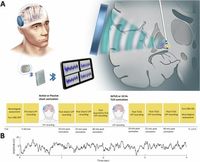A new study has demonstrated the potential of transcranial ultrasound stimulation (TUS) as a non-invasive method to modulate deep brain circuits, particularly in the treatment of movement disorders such as Parkinson's disease. TUS, which uses low-intensity ultrasound waves, was evaluated in both patients with movement disorders and healthy individuals to assess its ability to influence brain activity in the globus pallidus internus (GPi), a key region involved in motor control.
In the research, published in a recent issue of an unspecified scientific journal, scientists focused on two experiments. The first experiment involved 10 patients with movement disorders who had deep brain stimulation (DBS) electrodes implanted in their GPi. By applying specific ultrasound protocols—theta burst TUS (tbTUS) and 10 Hz TUS—and monitoring local field potentials (LFPs) via the implanted electrodes, researchers aimed to determine how these ultrasound protocols affected brain activity.
The results were significant. Both tbTUS and 10 Hz TUS protocols led to substantial increases in overall LFP power in the GPi compared to sham conditions. Specifically, tbTUS increased the overall power in the theta frequency band, while the 10 Hz protocol enhanced beta power. The changes in LFPs were observed not only during the stimulation but also persisted for up to 40 minutes afterward, showcasing TUS's potential to influence brain function beyond immediate effects.
In a second experiment, 15 healthy participants were recruited to evaluate the behavioral implications of TUS on response inhibition—an essential cognitive control process involving the ability to withhold responses when necessary. They performed a stop-signal task, which measures inhibition, after receiving tbTUS on the GPi and pulvinar (a control region). The findings were compelling; tbTUS applied to the GPi significantly prolonged stop-signal reaction times, indicating impaired response inhibition, whereas stimulation of the pulvinar had no measurable impact on performance.
The implications of these findings could be profound for treating neurological and psychiatric disorders. TUS's ability to precisely modulate activity in deep brain structures opens new avenues for therapies that traditionally relied on invasive methods like DBS. Moreover, this research provides direct electrophysiological evidence of TUS's engagement with specific brain regions, offering insights that could revolutionize how clinicians approach disorders that involve altered brain function.
Notably, patients did not report any adverse effects from the ultrasound stimulation, indicating its safety. However, further studies are required to expand on these findings, particularly investigations into how variations in stimulation parameters affect outcomes in diverse patient populations.
This study marks a significant step forward in understanding and harnessing TUS for neuromodulation, potentially paving the way for innovative treatment options for conditions such as Parkinson's disease, epilepsy, and other neurological disorders.




